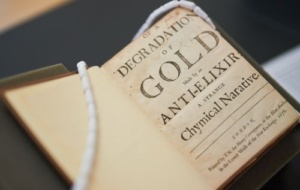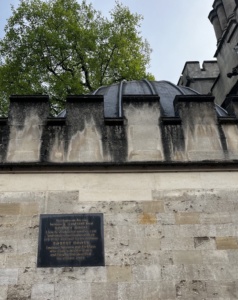Robert Boyle and Univ

Degradation of Gold
From the High Street, part of the western range of Univ presents something of a conundrum to passers-by. The plaque that commemorates the site of the house in which Robert Boyle lived is attached to a single-story windowless wall with battlements, behind which can be seen a shapely dome with a leaded roof. One could be forgiven for thinking that the dome is part of the laboratory in which Boyle discovered the law which now takes his name. In fact, Deep Hall, which Boyle rented, was demolished in 1809, and the dome now visible belongs to the Shelley Memorial which was inaugurated in 1893.
In a house on this site between 1655 and 1668 lived Robert Boyle. Here he discovered Boyle’s Law and made experiments with an air pump designed by his assistant Robert Hooke Inventor Scientist and Architect who made a microscope and thereby first identified the living cell.
The plaque was put up following a letter from the then Sherardian Professor at Oxford, Cyril Darlintgon in 1964. Darlington’s letter, however didn’t mention Robert Boyle. His suggestion was for a plaque to celebrate Robert Hooke. This was his suggestion:
In a house on this site Robert Hooke worked, 1658-1664 Making a microscope for himself With which he first saw the cell. “By help of microscopes… there is a new Visible world discovered to the understanding. Micrographia 1665
After much correspondence and debate, the Master and Fellows decided on the form of wording that you can see today. It’s unclear why Darlington didn’t include Boyle in his original letter, but as Sherardian Professor of Botany, it’s understandable that he was more focussed on cells and microscopes than theories of gases. Boyles Law, of course, concerns the relationship between pressure and volume of a confined gas. When Boyle lived in Deep Hall, from 1655 to 1668, it belonged not to Univ, but to Christ Church. Univ only acquired the site in 1773. From the records that survive, it seems that in the early 1770s, Univ was concerned about running short of student accommodation. Matriculation numbers from 1769 to 1771 showed a marked increase. The purchase of Deep Hall in 1773 would have given the College the rooms necessary to cater for a growing student body. As it happened, 1771 was an anomaly in terms of matriculation numbers, and by 1809, only nine students were matriculated.
By the late 18th century, records show that the focus of Univ’s Fellows had shifted from student numbers to the provision of a suitable lodging for the then Master, Nathan Wetherell. At that time, the Master’s lodgings were along the eastern range of Radcliffe Quad. These rooms had never been popular with the Masters (or their families) who lived there, as the rooms were rather cramped and a bit dark. In fact, Elizabeth Sheppard, the 18th-century memoirist, describes the Lodgings as looking like a coffin from Logic Lane (Sheppard, p.25). By 1798, it was suggested that Deep Hall, was ‘in so ruinous a condition’ (Darwall-Smith, p.298) that it should be demolished to provide space for a new Lodgings. A lack of funds meant that this plan never came to fruition so Deep Hall stood but, we can suppose, continued to deteriorate.

Boyle plaque
A view of Oxford’s High Street, painted by J.M.W. Turner (https://www.ashmolean.org/collections-online#/item/ash-object-384480) in 1809/10, gives us a glimpse of what Deep Hall looked like just before its demolition. It’s even possible that the four men Turner has painted with a ladder leaning against the building were beginning the process of pulling the building down to make way for the Fellow’s Garden. The High Street end of the plot remained vacant until the Shelley Memorial was completed in 1893. Robert Boyle, as well as being our neighbour, was a benefactor to the College. In 1655, the Master and Fellows decided to raise funds to finish the Hall. Work had begun on the south side of the Main Quad in 1639, but only the walls of the Hall had been completed by the outbreak of war. In the mid-1650s, benefactors within the College were hard to come by and the Master and Fellows were driven to look further afield. The eminent scientist who had just moved in next door must have seemed a godsend, and Boyle was approached. His donation of £10 towards the Hall’s new hammer beam roof is recorded in the Benefaction book (College Archive UC:BE1/MS1/1).
When Boyle left Oxford for London in 1668, he was only at the beginning of his publishing career. One of his later, more controversial, works can be found in the College Library. This rare pamphlet (fig.3), Of a degradation of gold made by an anti-elixir: a strange chymical narrative, recounts an experiment which claims to perform alchemy in reverse. Although transmutations of the elements were not scientifically possible in the 17th century, Robert Boyle was a firm believer in alchemy.
This work dates from 1678, a time when Boyle was known to be dabbling in more controversial subjects (see his entry in ODNB). While alchemists were mostly interested in turning base metals (like lead) into noble metals like gold, in this text, Boyle outlines an experiment in which gold was transformed into a base metal. Although not named on the title page, Boyle was widely acknowledged to be the author of the work and, indeed, his name appears in the second edition (also published within Boyle’s lifetime).
The text is written in narrative form: a group of people hear (the un-named) Boyle recount the details of an experiment conducted by his mentor, Pyrophilus. Sounding rather like the kind of tall story that comes out towards closing time at the pub, Boyle relates how Pyrophilus, whilst at the house of a friend, meets a well-travelled stranger. Pyrophilus asks him if he has ever met any ‘chymists’ on his travels and gets a positive reply. The stranger was hurrying to catch a boat out of England but stops long enough to give Pyrophilus a packet of folded paper. Inside is a dark red powder said to have the power to degrade gold.
Pyrophilus, like all good scientists, wants to test this claim and makes plans to conduct two experiments. He finds a witness (Boyle) in addition to his laboratory assistant, who agreed to be present. On opening the packet, they found too small an amount of powder for two experiments, so had to content themselves with one. They duly melted two drams of gold in a crucible and added the (unweighed) powder. The resulting mass was deemed, after much testing, to have been transformed into something other than gold. It was brittle rather than malleable like gold, and the interior had a dirty colour more akin to silver. Boyle, his witness, and the laboratory assistant considered the experiment a success! What’s more, the men who listened to Boyle’s account of the experiment, agreed.
So what happened? We can assume that Boyle did not actually turn gold into silver. Might he have been joking, or outright lying? These suggestions seem unlikely given that Boyle was a highly regarded scientist whose honestly-held belief in alchemy is revealed in his later works. Perhaps the experiment was so flawed that the result is not to be trusted? This hypothesis also seems unlikely. Boyle was known for his insight and knowledge of experimental problems. In the tract he outlines the scientific method used in the experiment, and there are no obvious flaws or points at which errors could have been introduced. So perhaps something more underhand was happening. Could one of the laboratory assistants, knowing how much was at stake with this experiment, have deliberately falsified the outcome of the experiment to please his master or bolster his reputation? It’s unlikely we’ll ever know for sure.
Bibliography:
Robert Boyle (1627-1691): Of a degradation of gold made by an anti-elixir: a strange chymical narrative (London: Printed by T.N. for Henry Herringman, at the Blew Anchor in the Lower Walk of the New Exchange, 1678) Shelf-mark: R.15.22(1).
Robin Darwall-Smith A history of University College Oxford (Oxford, 2008).
Robin Darwall-Smith ‘The medieval buildings of University College, Oxford’, in Oxoniensia 2005, pp. 9-26.
Michael Hunter “Boyle, Robert (1627-1691), natural philosopher.” Oxford Dictionary of National Biography. 23 Sep. 2004; accessed 19 Apr. 2024. https://www.oxforddnb.com/view/10.1093/ref:odnb/9780198614128.001.0001/odnb-9780198614128-e-3137
Aaron J. Ihde “Alchemy in reverse: Robert Boyle on the degradation of gold.” Chymia 9 (1964) pp. 47-57. https://doi.org/10.2307/27757231.
‘University College’, in A History of the County of Oxford: Volume 3, the University of Oxford, (London, 1954) pp. 61-81. British History Online https://www.british-history.ac.uk/vch/oxon/vol3/pp61-81 [accessed 11 April 2024].
‘Modern Oxford’, in A History of the County of Oxford: Volume 4, the City of Oxford, (London, 1979) pp. 181-259. British History Online https://www.british-history.ac.uk/vch/oxon/vol4/pp181-259 [accessed 11 April 2024]
Elizabeth Sheppard (and G. Neate, ed.), Memoirs of the City and University of Oxford in 1738 : together with poems, odd lines, fragments and small scraps, by “Shepilinda” (Elizabeth Sheppard) (Oxford: The Boydell Press, 2018).
